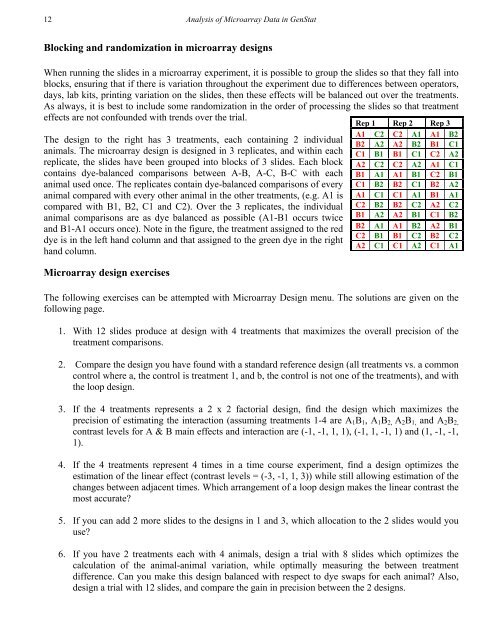Analysis of microarray data - VSN International
Analysis of microarray data - VSN International
Analysis of microarray data - VSN International
- No tags were found...
Create successful ePaper yourself
Turn your PDF publications into a flip-book with our unique Google optimized e-Paper software.
12<strong>Analysis</strong> <strong>of</strong> Microarray Data in GenStatBlocking and randomization in <strong>microarray</strong> designsWhen running the slides in a <strong>microarray</strong> experiment, it is possible to group the slides so that they fall intoblocks, ensuring that if there is variation throughout the experiment due to differences between operators,days, lab kits, printing variation on the slides, then these effects will be balanced out over the treatments.As always, it is best to include some randomization in the order <strong>of</strong> processing the slides so that treatmenteffects are not confounded with trends over the trial.Rep 1 Rep 2 Rep 3The design to the right has 3 treatments, each containing 2 individualanimals. The <strong>microarray</strong> design is designed in 3 replicates, and within eachreplicate, the slides have been grouped into blocks <strong>of</strong> 3 slides. Each blockcontains dye-balanced comparisons between A-B, A-C, B-C with eachanimal used once. The replicates contain dye-balanced comparisons <strong>of</strong> everyanimal compared with every other animal in the other treatments, (e.g. A1 iscompared with B1, B2, C1 and C2). Over the 3 replicates, the individualanimal comparisons are as dye balanced as possible (A1-B1 occurs twiceand B1-A1 occurs once). Note in the figure, the treatment assigned to the reddye is in the left hand column and that assigned to the green dye in the righthand column.Microarray design exercisesA1 C2 C2 A1 A1 B2B2 A2 A2 B2 B1 C1C1 B1 B1 C1 C2 A2A2 C2 C2 A2 A1 C1B1 A1 A1 B1 C2 B1C1 B2 B2 C1 B2 A2A1 C1 C1 A1 B1 A1C2 B2 B2 C2 A2 C2B1 A2 A2 B1 C1 B2B2 A1 A1 B2 A2 B1C2 B1 B1 C2 B2 C2A2 C1 C1 A2 C1 A1The following exercises can be attempted with Microarray Design menu. The solutions are given on thefollowing page.1. With 12 slides produce at design with 4 treatments that maximizes the overall precision <strong>of</strong> thetreatment comparisons.2. Compare the design you have found with a standard reference design (all treatments vs. a commoncontrol where a, the control is treatment 1, and b, the control is not one <strong>of</strong> the treatments), and withthe loop design.3. If the 4 treatments represents a 2 x 2 factorial design, find the design which maximizes theprecision <strong>of</strong> estimating the interaction (assuming treatments 1-4 are A 1 B 1 , A 1 B 2, A 2 B 1, and A 2 B 2,contrast levels for A & B main effects and interaction are (-1, -1, 1, 1), (-1, 1, -1, 1) and (1, -1, -1,1).4. If the 4 treatments represent 4 times in a time course experiment, find a design optimizes theestimation <strong>of</strong> the linear effect (contrast levels = (-3, -1, 1, 3)) while still allowing estimation <strong>of</strong> thechanges between adjacent times. Which arrangement <strong>of</strong> a loop design makes the linear contrast themost accurate?5. If you can add 2 more slides to the designs in 1 and 3, which allocation to the 2 slides would youuse?6. If you have 2 treatments each with 4 animals, design a trial with 8 slides which optimizes thecalculation <strong>of</strong> the animal-animal variation, while optimally measuring the between treatmentdifference. Can you make this design balanced with respect to dye swaps for each animal? Also,design a trial with 12 slides, and compare the gain in precision between the 2 designs.
















